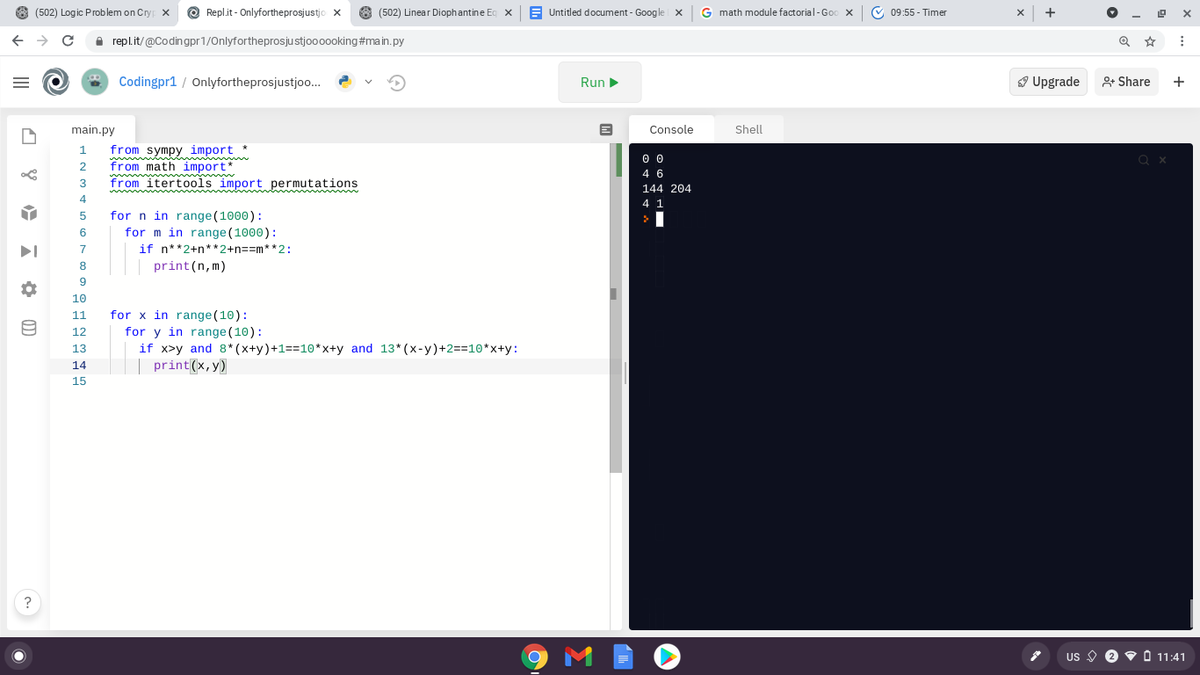Two-Digit Puzzle
Find the two digit positive integer that is equal to:
- one more than eight times the sum of its digits
AND
- two more than the product of 13 and the positive difference between its digits.
The answer is 41.
This section requires Javascript.
You are seeing this because something didn't load right. We suggest you, (a) try
refreshing the page, (b) enabling javascript if it is disabled on your browser and,
finally, (c)
loading the
non-javascript version of this page
. We're sorry about the hassle.
8 solutions
In fact you don't need the second equation, there is a single number who match the 8(x+y)+1=10x+y ; 7y+1=2x so y=0 or 1. If y=0 we got 2x=1 ; x=0.5 so impossible. If y=1 ; x=4 (which verify the 2nd equation too)
How do u get 10 x + y ?
Log in to reply
x is the 10's digit and y is the one's digit. therefore the number is equal to (10 x + y). for example if the number is 25 then it can also be written as (2 10 + 5) wherein 2 is the ten's digit and 5 is the one's digit
We should solve also for x ≤ y to to be sure there's not another solution (there isn't, the other system has no integral solutions).
Also notice:
Let x be our 2-digit number. x must be one more than a multiple of 8, i.e. x =8 a +1 for some integer a . Going through the different 2-digit possibilities for x , (17, 25, 33, 41, 49, 57, 65, 73, 81, 89, 97), 41 is the only possibility where a happens to be the sum of the digits of x .
Likewise, we are given x must be two more than a multiple of 13, i.e. x =3 b +2 for some integer b . Going through the different 2-digit possibilities for x , (15, 28, 41, 54, 67, 80, 93), 41 is the only possibility where b happens to be the difference of the digits of x .
You really only need one of the premises in order to solve the problem. Additionally, 41 is the only number that is on both lists, so the fact that we are dealing with sums and differences of digits is irrelevant if given both premises.
The second condition is redundant. Let 1 0 a + b be our 2-digit number.
The first condition gives: 1 0 a + b = 8 ( a + b )
a = 2 1 ( 7 b + 1 ) . Since a , b are digits between 0 and 9, we can only have b = 1 , a = 4
let t=tens digit
and u=units digit
so the the two digit #=10t + u
10t + u=8(t+u)+1
10t + u=13(t-u)+2
t=4 and u=1
therefore the # is 41
Let the first digit be X and the second digit be Y
From the first condition we have that 1 0 X + Y = 1 + 8 ( X + Y ) ⟹ 2 X − 7 Y = 1
From the second condition we have that 1 0 X + Y = 2 + 1 3 ∣ X − Y ∣
From the first equation, 2 X − 7 Y = 1 ⟹ 2 X = 7 Y + 1 ⟹ 2 X > 7 Y ⟹ X > 2 7 Y ⟹ X > Y
Combining the previous fact with the second equation,
1 0 X + Y = 2 + 1 3 ∣ X − Y ∣ ⟹ 1 0 X + Y = 2 + 1 3 ( X − Y ) ⟹ 3 X − 1 4 Y = − 2
We now have the following system of equations
{ 2 X − 7 Y = 1 3 X − 1 4 Y = − 2
Solving it yield: X = 4 , Y = 1 Therefore, the number is 4 1
N = 10p + q = 8(p + q) + 1 = 13|p - q| + 2
2p = 7q + 1 < 20
7q < 20 - 1 = 19
q < 19/7 ==> 0 ≤ q < 3
2p = 7q + 1
LHS is even, so RHS should also be even.
Then, 7q must be odd. ==> q must be odd, too.
The only odd number in the above range is q = 1, thus p = 4
N = 10 x 4 + 1 = 41
I used code to solve this and dont mind the first three lines of output:

From the second part the answer must be 2 modulo 13, but from the first part it must be 1 modulo 8 (in particular it must be odd) That only allows for 15, 41, 67, 93 of which only 41 is 1 modulo 8..
L e t t h e 2 d i g i t n u m b e r b e 1 0 x + y w h e r e x > y W e k n o w 8 ( x + y ) + 1 = 1 0 x + y a n d 1 3 ( x − y ) + 2 = 1 0 x + y S o l v i n g t h e s y s t e m o f l i n e a r e q u a t i o n s i n 2 v a r i a b l e s , w e g e t : x = 4 a n d y = 1 T h u s t h e n u m b e r i s 4 1 .